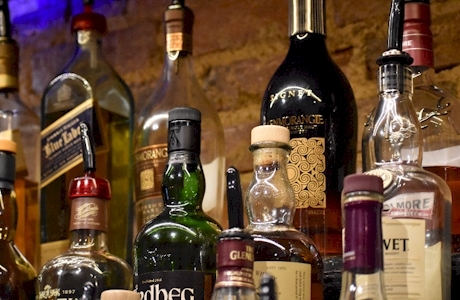SCOTCH WHISKY TYPES
There are five basic types of Scotch: Single Malt, Blended Malt (a.k.a. Vatted or Pure Malt), Blended, Single Grain, and Blended Grain. Although single grain and blended grain Scotches are primarily for blending with malts, there are some quality Scotches in those categories. The most common types of Scotch and our primary focus are single malt, blended, and blended malt. Blended Scotch makes up over 90% of worldwide Scotch sales, while single malt Scotch is considered the pinnacle of quality and prestige.
- Single Malt Scotch
Malt whisky is created by distilling fermented malted barley. The term “single” refers solely to sourcing the malts from one distillery. By definition, it can (and often does) include blends of multiple malts from the same distillery. Single malt whiskies usually possess higher intensity and depth of character than “blended Scotch” and generally command higher prices. Some of my favorite single malts include:- Lagavulin 16
- Laphroaig 10
- The Macallan 12
- Bowmore Darkest 15
- Glenmorangie Lasanta 12
- Blended Malt Scotch Whisky (aka Vatted or Pure Malt)
Scotch blending is an art that developed over the years to enhance the quality and flavor of each scotch whisky. Blended Malts, unlike standard blended Scotch whisky, must be made from 100% malted Scotch whisky. These whiskies can combine malts from different distilleries. This process allows distillers and blenders to introduce specific flavors and characteristics to their whiskies by selecting component whiskies noted for the desired attribute. Blended malts tend to be very consistent, often with highly distinguishable traits. Some of the more prominent blended-malt makers include:- Monkey Shoulder
- Black Bottle
- Compass Box
- Sheep Dip
- Shackleton
- Tambowie
- Blended Scotch Whisky
With the advent of the column (Coffey) still in the 1800s, distillers produced lighter whiskies using non-malted grains, including unmalted barley, corn, wheat, and even rice. The lighter whisky appealed to a broader audience, and coupled with lower costs and faster production, demand expanded. Competition and consumer experience skyrocketed, driving desire for better-tasting whiskies. Adding higher percentages of malt resulted in increasingly sophisticated blends. Today, blended Scotch forms the backbone of the industry, accounting for 90% of all Scotch produced. Blending allows distillers a broad palate, and the ability to create quality Scotch for less than malts. Blending is an art form that many of the world’s best selling brands have perfected.- Johnny Walker (Number 1 seller worldwide)
- Chivas Regal
- Famous Grouse
- Dewar’s
- Teacher’s
- Carlyle
- Single and Blended Grain Scotch
As previously noted, the term “single” designates that all whiskies in the bottle came from one distillery. The word “grain” indicates the absence of malted barley. Because it’s usually simpler and lighter, with fewer overwhelming attributes, grain whisky is distilled primarily for blending. Although common in American, Canadian, and other whiskeys, there are only a few noteworthy grain Scotches, some of highly regarded, including:- Strathcolm Single Grain (8 and 12 years)
- Hamilton’s Lowland
- Compass Box Hedonism (highly rated)
- Port Dundas Old Particular

